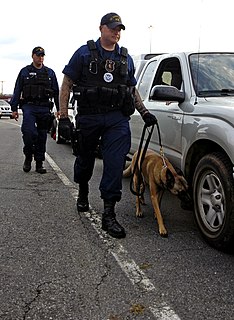
The United States Department of Homeland Security (DHS) is the U.S. federal executive department responsible for public security, roughly comparable to the interior or home ministries of other countries. Its stated missions involve anti-terrorism, border security, immigration and customs, cyber security, and disaster prevention and management.

The Federal Protective Service (FPS) is the uniformed police division of the United States Department of Homeland Security (DHS). It is also "the federal agency charged with protecting and delivering integrated law enforcement and security services to facilities owned or leased by the General Services Administration (GSA)"—over 9,000 buildings—and their occupants.
The United States Computer Emergency Readiness Team (US-CERT) is an organization within the Department of Homeland Security’s (DHS) Cybersecurity and Infrastructure Security Agency (CISA). Specifically, US-CERT is a branch of the Office of Cybersecurity and Communications' (CS&C) National Cybersecurity and Communications Integration Center (NCCIC).

The National Cyber Security Division (NCSD) is a division of the Office of Cyber Security & Communications, within the United States Department of Homeland Security's Cybersecurity and Infrastructure Security Agency. Formed from the Critical Infrastructure Assurance Office, the National Infrastructure Protection Center, the Federal Computer Incident Response Center, and the National Communications System, NCSD opened on June 6, 2003. The NCSD mission is to collaborate with the private sector, government, military, and intelligence stakeholders to conduct risk assessments and mitigate vulnerabilities and threats to information technology assets and activities affecting the operation of the civilian government and private sector critical cyber infrastructures. NCSD also provides cyber threat and vulnerability analysis, early warning, and incident response assistance for public and private sector constituents. NCSD carries out the majority of DHS’ responsibilities under the Comprehensive National Cybersecurity Initiative. The FY 2011 budget request for NCSD is $378.744 million and includes 342 federal positions. The current director of the NCSD is John Streufert, former chief information security officer (CISO) for the United States Department of State, who assumed the position in January 2012.

The Homeland Security Act (HSA) of 2002, was introduced in the aftermath of the September 11 attacks and subsequent mailings of anthrax spores. The HSA was cosponsored by 118 members of Congress. The act passed the U.S. Senate by a vote of 90–9, with one Senator not voting. It was signed into law by President George W. Bush in November 2002.
The Australian Intelligence Community (AIC) and the National Intelligence Community (NIC) or National Security Community of the Australian Government are the collectives of statutory intelligence agencies, policy departments, and other government agencies concerned with protecting and advancing the national security and national interests of the Commonwealth of Australia. The intelligence and security agencies of the Australian Government have evolved since the Second World War and the Cold War and saw transformation and expansion during the Global War on Terrorism with military deployments in Afghanistan, Iraq and against ISIS in Syria. Key international and national security issues for the Australian Intelligence Community include terrorism and violent extremism, cybersecurity, transnational crime, the rise of China, and Pacific regional security.

Critical infrastructure protection (CIP) is a concept that relates to the preparedness and response to serious incidents that involve the critical infrastructure of a region or nation.
In the United States, fusion centers are designed to promote information sharing at the federal level between agencies such as the Federal Bureau of Investigation, the U.S. Department of Homeland Security, the U.S. Department of Justice, and state, local, and tribal law enforcement. As of February 2018, the U.S. Department of Homeland Security recognized 79 fusion centers. Fusion centers may also be affiliated with an emergency operations center that responds in the event of a disaster.
The counter-terrorism page primarily deals with special police or military organizations that carry out arrest or direct combat with terrorists. This page deals with the other aspects of counter-terrorism:
The Joint Regional Information Exchange System (JRIES) began in December 2002 as an all-source intelligence / information sharing system, designed initially as a grassroots pilot system to connect the California Anti-Terrorism Information Center, the New York Police Department, and the Defense Intelligence Agency (DIA).
The United States National Response Framework (NRF) is part of the National Strategy for Homeland Security that presents the guiding principles enabling all levels of domestic response partners to prepare for and provide a unified national response to disasters and emergencies. Building on the existing National Incident Management System (NIMS) as well as Incident Command System (ICS) standardization, the NRF's coordinating structures are always in effect for implementation at any level and at any time for local, state, and national emergency or disaster response.
The California Governor's Office of Emergency Services is a California cabinet-level office responsible for overseeing and coordinating emergency preparedness, response, recovery and homeland security activities within the state. The agency was created by AB 38 (2008), superseding both the Office of Emergency Services (OES) and Office of Homeland Security (OHS).

Homeland Security Grant Program (HSGP) is a program in the United States established in 2003 and was designated to incorporate all projects that provide funding to local, state, and Federal government agencies by the Department of Homeland Security. The purpose of the grants is to purchase surveillance equipment, weapons, and advanced training for law enforcement personnel in order to heighten security. The HSGP helps fulfill one of the core missions of the Department of Homeland Security by enhancing the country's ability to prepare for, prevent, respond to and recover from potential attacks and other hazards. The HSGP is one of the main mechanisms in funding the creation and maintenance of national preparedness, which refers to the establishment of plans, procedures, policies, training, and equipment at the Federal, State, and local level that is needed to maximize the ability to prevent, respond to, and recover from major events such as terrorist attacks, major disasters, and other emergencies. The HSGP's creation stemmed from the consolidation of six original projects that were previously funded by the Office of State and Local Government Coordination and Preparedness. The HSGP now encompasses five projects in the program: State Homeland Security Program, Urban Areas Security Initiative, Operation Stonegarden, Metropolitan Medical Response System Program, and Citizen Corps Program. During the 2010 fiscal year, the Department of Homeland Security will spend $1,786,359,956 on the Homeland Security Grant Program.
The Information Sharing Environment (ISE) was established by the United States Intelligence Reform and Terrorism Prevention Act of 2004. Under Section 1016 of IRTPA, the Program Manager for the Information Sharing Environment (PM-ISE) was granted government wide authority to plan for, oversee the implementation of, and manage the ISE.

A Visible Intermodal Prevention and Response team, sometimes Visible Intermodal Protection and Response (VIPR) is a Transportation Security Administration program. Various government sources have differing descriptions of VIPR's exact mission. It is specifically authorized by 6 U.S.C. § 1112 which says that the program is to "augment the security of any mode of transportation at any location within the United States". Authority for the program is under the Secretary of Homeland Security. The program falls under TSA's Office of Law Enforcement/Federal Air Marshal Service. TSA OLE/FAMS shares responsibility for the program with the Office of Security Operations and Transportation Sector Network Management.

The National Cybersecurity and Critical Infrastructure Protection Act of 2013 is a bill that would amend the Homeland Security Act of 2002 to require the Secretary of the Department of Homeland Security (DHS) to conduct cybersecurity activities on behalf of the federal government and would codify the role of DHS in preventing and responding to cybersecurity incidents involving the Information Technology (IT) systems of federal civilian agencies and critical infrastructure in the United States.
Intelligence sharing is "the ability to exchange intelligence, information, data, or knowledge among Federal, state, local or private-sector entities as appropriate." Intelligence sharing also involves intergovernmental bilateral or multilateral agreements and through international organizations. Intelligence sharing is meant to facilitate the use of actionable intelligence to a broader range of decision-makers.
The New Jersey Cybersecurity and Communications Integration Cell (NJCCIC), also known as the New Jersey Office of Homeland Security and Preparedness' (NJOHSP) Division of Cybersecurity, is the first American state-level information sharing and analysis organization in the United States that exchanges cyber threat intelligence and conducts incident response for governments, businesses, and citizens in New Jersey. Located at NJ’s Regional Operations and Intelligence Center (ROIC), and acting in a cyber fusion center capacity the NJCCIC is composed of staff from NJOHSP, the NJ Office of Information Technology, and the NJ State Police. The NJCCIC's nomenclature is derived from its federal counterpart, the National Cybersecurity and Communications Integration Center, which encompasses the U.S. Department of Homeland Security's Computer Emergency Readiness Team (US-CERT).
The Department of Home Affairs is the Australian Government interior ministry with responsibilities for national security, law enforcement, emergency management, border control, immigration, refugees, citizenship, transport security and multicultural affairs. The portfolio also includes federal agencies such as the Australian Federal Police, Australian Border Force and the Australian Security Intelligence Organisation. The Home Affairs portfolio reports to the Minister for Home Affairs, currently held by Clare O'Neil, and is led by the Secretary of the Department of Home Affairs, Mike Pezzullo. In 2022, the Australian Federal Police, Australian Criminal Intelligence Commission and Australian Transaction and Analysis Center were de-merged from the department and moved to the Attorney General portfolio.
DHS media monitoring services is a proposed United States Department of Homeland Security database to keep track of 290,000 global news sources and media influencers to monitor sentiment.





